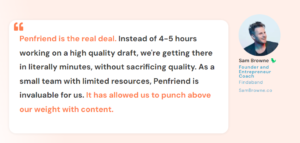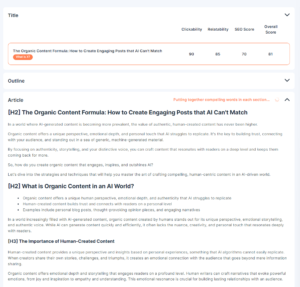Taking your first step into the world of content creation can feel like navigating a minefield.
Echoing the thrill and terror of a tightrope walker’s first step onto the wire, you’re balancing the weight of your ideas on the thin line of a blank page. But what if I told you that you’re about to discover a roadmap that makes this journey less daunting and far more rewarding?
Much like assembling a Lego set, creating your first piece of content can be broken down into easily manageable parts. This is your step-by-step guide, stringing together these fragments to craft a content masterpiece. Prepare to navigate through conceptualization, drafting, editing, and sharing – transforming the ordinary blank page into a digital canvas brimming with your ideas.
Happy tightrope-walking!
Prefer listening to reading? Grab the audio discussion here:
Step-by-Step Guide to Creating Your First Piece of Content
Master the art of content creation through these straightforward steps:
- Identify your content’s purpose to create targeted results.
- Understand your audience’s needs to deliver value.
- Choose the right format to enhance message delivery.
- Craft engaging content for enhanced reader experience.
- Implement effective reviewing and editing practices to achieve polished output.
Step 1: Identifying Your Content’s Purpose
The kingpin of effective content creation is understanding its purpose. As you embark on formulating your first piece of content, it is essential to recognize why you’re creating it. That could be generating leads, educating your audience, or strengthening your brand.
Establishing a clear purpose ensures your content stays focused, is more impactful, and easier to measure its success. For instance, if your content is intended to generate leads, your call-to-action might involve asking readers to sign up for more information.
Step 2: Researching Your Audience
Knowing who you’re speaking to is a cornerstone of content marketing. Techniques for effective audience research include demographic analysis, psychographic profiling, and social listening.
By understanding your audience’s needs, preferences, and pain points, you can create content that resonates with them. Whether your audience prefers quick, informative articles, or in-depth white papers, understanding these preferences can shape your content creation process.
Step 3: Choosing the Right Content Format
The medium is the message. Each content format, be it a blog post, a video, or an infographic, has its unique advantages. For example, video content can deliver complex messages in an easily digestible format, while a blog post can provide in-depth analysis on a topic.
Choosing the right format can enhance your message delivery, making it more compelling and engaging to your audience. Consider your audience preferences, and the type of information you’re delivering, then select the format that best fits.
Step 4: Crafting Your Content
When it comes to creating engaging content, originality and authenticity are key. This means not only providing valuable insights but also delivering them in a relatable and unique way.
Tips for generating compelling content include storytelling, using visuals, and incorporating data.
Remember, content creation is about providing value to your audience, which requires putting enough effort into providing unique and reliable information.
Step 5: Reviewing and Editing Your Content
The last, but not the least important, step in content creation is reviewing and editing. This process is essential for polishing your content, ensuring it’s void of errors, and conveys your message effectively.
Effective reviewing involves checking for grammar and spelling errors, as well as ensuring that the content flows well. But it’s not all about fixing mistakes. It’s about fine-tuning your message, making sure that it’s clear and impactful.
Essential Tools and Resources for Content Creation
- Discover a variety of tools beneficial to content creation
- Understand how to choose tools that suit your specific needs
- Learn which resources can further your content creation knowledge and why continuous learning is so vital
Content Creation Tools
There’s a myriad of tools available that can enhance your content creation process. From graphic design applications, SEO platforms to writing aids, the right tool can save time, increase efficiency, and improve the quality of your content significantly.
Whether you choose to use websites like Canva for infographics, SEMrush for search engine optimization, Penfriend for content creation, Grammarly for proofreading, or CoSchedule for scheduling, greatly depends on your unique requirements and content goals.
Establishing your precise content creation needs not only saves time but ensures that you invest in the right tools. When examining content tools, consider their ease of use, functionality, reliability, and value for money. Do not let popularity sway your decision. What works well for others may not be the right fit for you.
Also, don’t overlook the importance of quality backlinks (links from other websites back to your website). Creating content that others find valuable enough to link to can significantly boost your SEO.
Penfriend.ai leverages advanced AI to create engaging, shareable content that attracts backlinks from reputable sites. This helps improve your site’s domain authority and search engine rankings.

How to Create Link-Building Content with Penfriend
- Sign In and Access the Dashboard:
- Log in to your Penfriend.ai account and navigate to the dashboard.

- Set Your Content Goals:
- Define the objectives for your link-building content, such as improving domain authority or driving traffic.
- Identify Link-Building Opportunities:
- Research high-authority sites in your industry that accept guest posts or link to valuable resources.
- Generate High-Quality Content:
- Use Penfriend.ai to create informative and engaging content that other sites would want to link to in just 3 clicks. Use the “Cluster” feature to generate hub and spoke content that’s internally linked.

- Input Relevant Topics:
- Enter topics and keywords that are likely to attract backlinks from authoritative sites.
- Generate the Blog Post:
- Use Penfriend.ai to create a draft of your link-building content.
- Review and Edit:
- Customize the content to ensure it is valuable and shareable.
- Publish and Promote:
- Publish the content on your website and reach out to other sites to promote it.
Learning Resources for Content Creation
Access to knowledge has never been easier as it is today. A plethora of resources, both paid and free, are available to help you understand everything from the basics to the tiniest intricacies of content creation.
Online platforms such as Coursera, Udemy, LinkedIn Learning provide comprehensive courses on content creation. Reading blogs like Penfriend’s content marketing blog and subscribing to newsletters from credible sources like Neil Patel can help keep you updated on industry trends and best practices.
In the world of content creation, learning is non-negotiable. As algorithms and user preferences continue to evolve, the creator must adapt. This is where continuous learning becomes crucial, allowing creators to stay ahead of the curve and craft highly effective content for their targeted audience.
Understanding the importance of suitable tools separates an impressive piece of writing from one that gets lost in the crowd. As the landscape of content creation continues to evolve, fostering a culture of continuous learning has never been more critical to stay ahead.
Let’s now uncover the commonly faced challenges in the world of content, and of course, tips to help overcome them.
Spoiler – there’s always a solution.
Common Challenges in Content Creation and How to Overcome Them
- You’ll uncover the mystery behind common content creation issues and acquire strategies for overcoming them.
- Discover why consistency matters and how to keep your content creation process consistent.
- Learn why quality in your content is crucial and strategies to ensure it.
Overcoming Writer’s Block
You’re sitting at your keyboard, ready to create amazing content but…nothing comes. This is the dreaded ‘writer’s block’ a phenomenon that hinders the flow of ideas and freezes your creative process.
Fortunately, writer’s block is not impenetrable. There are numerous tested strategies that can help disintegrate this obstacle. Whether it’s taking a mental break or engaging in creative exercises, different approaches can trigger the unruly flow of ideas.
Maintaining Consistency in Content Creation
Images of dripping faucets come to mind when discussing consistency in content creation; it’s a slow, steady process. However, just as a dripping faucet can fill a bathtub, consistent content creation can accumulate a significant digital presence.
Keeping your content creation schedule consistent is not merely important, but vital. Consistency equals visibility in the digital world. But maintaining consistency isn’t always a smooth ride, it requires planning, discipline, and sometimes, a touch of creativity. Tips such as creating a content calendar or employing productivity tools can help maintain your rhythm and keep that ‘faucet’ dripping.
Ensuring Quality in Your Content
In the realm of content creation, quality is queen. It takes the throne in converting views into followers, users, or clients. If consistency is what gets your content seen, quality is what keeps them coming back for more.
To ensure quality content, there are key elements to consider like accuracy, relevancy, and content readability. These factors, coupled with clear and concise communication, form the backbone of high quality content. Various strategies can be employed to ensure these elements are consistently met, such as peer reviews, utilizing grammar checking tools, and regularly updating your content to keep it relevant.
Understanding the Role of SEO in Content Creation
- Boost your content’s visibility with SEO
- Learn the strategies to incorporate SEO into your content creation
- Avoid common SEO mistakes to make your content more impactful
What is SEO and Why is it Important in Content Creation?
In the crowded digital landscape, Search Engine Optimization (SEO) is the not-so-secret weapon which can make your content stand out. SEO is the process of optimizing your online content so that a search engine prefers to show it as a top result for searches of a certain keyword. Optimized content means it is organized, useful, credible and responsive.
SEO is the driving force behind the visibility and reach of your content. Remember, creating top-notch content isn’t enough, you need to ensure it reaches your target audience as well. Google processes over 3.5 billion searches per day. High-ranking on search engines, thus, opens your content to a vast sea of potential readers and clients.
Adding SEO into Your Content Creation Process
Next, let’s get tactical. Incorporating SEO starts right when you begin brainstorming content ideas. It’s about choosing the right keywords, creating quality content around them and promoting your content effectively. One effective strategy is to use ‘long-tail’ keywords, which are more specific and less competitive. These keywords are easier to rank for and attract a more targeted audience.
While we talk about the need for SEO, there are a few common slip-ups that one must avoid. For example, keyword stuffing – using your target keyword too many times – can harm more than it can help. It not only hurts your SEO, but also makes your content less readable. Also, creating irrelevant links or spammy backlinks are definite no-nos.
Search engine algorithms are smarter now. Honesty – creating genuine, high-quality & relevant material – is the best policy here. SEO is not about tricking the system, it’s about working with the system to deliver valuable content to your audience. When in doubt, prioritize your reader’s interests over search engine bots.
Enjoy the process. Never let SEO overshadow your mission to create meaningful content. Keep your readers at the forefront and success will follow.
Content Creation Made Simple: Crafting Your Legacy
By now, you’ve seen that creating your first piece of content isn’t as daunting as it may initially appear. You’ve mastered the steps, from understanding your target audience, conducting keyword research, to composing high-quality, engaging content.
Why does this matter? It’s simple. Content creation is a necessity. It optimizes your brand’s visibility, sets you up as an authority in your field, and most importantly, it builds relationship with your customers.
Now the ball is in your court; it’s time to put these skills into practice. Brainstorm your ideas, delve deep into research, compose and then, press publish! Remember, every great content producer started where you’re standing right now.
So, will your next piece of content be an insightful blog post, a compelling case study or a fun infographic? Have you thought about which approach you would take and what you would create?
Embrace the challenge. Step onto the content creation stage. Because in the end, it’s not just about building a brand; it’s about crafting your legacy in digital ink.

